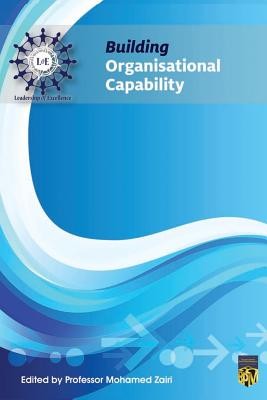
- We will send in 10–14 business days.
- Author: Professor Mohamed Zairi
- Publisher: INDEPENDENTLY PUBLISHED
- Year: 2019
- Pages: 176
- ISBN-10: 1793925534
- ISBN-13: 9781793925534
- Format: 15.2 x 22.9 x 1 cm, softcover
- Language: English
- SAVE -10% with code: EXTRA
Reviews
Description
Organisational capability is increasingly being acknowledged as the vehicle for establishing sustainable competitive advantage. Organisations, in the 21st century need to continually and dynamically manage their operations and enhance the value provision to their customers in an innovative way so as to achieve and maintain the competitive advantage. Organisational capability is often considered to be an amalgamation of people, structure, rewards and processes that are generated and created and combined together in order to support the performance outcome. Organisations must put in place the right structure, the right management processes and the right incentives and rewards to ensure that human resource practices are geared towards supporting the organisational desires and so the ultimate goal of adding value to the customers can ensue. The term "organisational capability" was made widespread by Dave Ulrich who emphasised that organisational capability is the key to the inside-out approach to business strategy i.e. the strategy is driven by capabilities and how a leader positions his/her organisation accordingly. Formally, he defined organisational capability as "Things a company knows how to do well, the ability of an organisation to use resources, get things done, and behave in ways that lead to accomplishment." This is fundamentally the resource based approach to strategic planning, development and implementation process. He goes on to identify eleven intangible capabilities that he believed were important for organisational effectiveness and efficiency, the identification was followed by grouping them together in four main dimensions - customer capital, human capital, organisational capital and social capital.
EXTRA 10 % discount with code: EXTRA
The promotion ends in 18d.00:26:32
The discount code is valid when purchasing from 10 €. Discounts do not stack.
- Author: Professor Mohamed Zairi
- Publisher: INDEPENDENTLY PUBLISHED
- Year: 2019
- Pages: 176
- ISBN-10: 1793925534
- ISBN-13: 9781793925534
- Format: 15.2 x 22.9 x 1 cm, softcover
- Language: English English
Organisational capability is increasingly being acknowledged as the vehicle for establishing sustainable competitive advantage. Organisations, in the 21st century need to continually and dynamically manage their operations and enhance the value provision to their customers in an innovative way so as to achieve and maintain the competitive advantage. Organisational capability is often considered to be an amalgamation of people, structure, rewards and processes that are generated and created and combined together in order to support the performance outcome. Organisations must put in place the right structure, the right management processes and the right incentives and rewards to ensure that human resource practices are geared towards supporting the organisational desires and so the ultimate goal of adding value to the customers can ensue. The term "organisational capability" was made widespread by Dave Ulrich who emphasised that organisational capability is the key to the inside-out approach to business strategy i.e. the strategy is driven by capabilities and how a leader positions his/her organisation accordingly. Formally, he defined organisational capability as "Things a company knows how to do well, the ability of an organisation to use resources, get things done, and behave in ways that lead to accomplishment." This is fundamentally the resource based approach to strategic planning, development and implementation process. He goes on to identify eleven intangible capabilities that he believed were important for organisational effectiveness and efficiency, the identification was followed by grouping them together in four main dimensions - customer capital, human capital, organisational capital and social capital.


Reviews